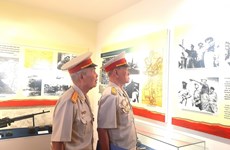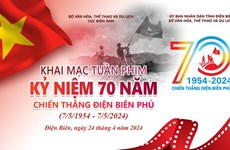Carvings on Nguyen Dynasty’s urns affirms Vietnam’s sovereignty over Hoang Sa, Truong Sa islands
 Cuu Dinh, or Nine Dynastic Urns, are national treasures of Vietnam, embodying the power and supremacy of the Nguyen Dynasty (1802 – 1945). (Photo: VNA)
Cuu Dinh, or Nine Dynastic Urns, are national treasures of Vietnam, embodying the power and supremacy of the Nguyen Dynasty (1802 – 1945). (Photo: VNA)Hanoi (VNA) – Cuu Dinh, or Nine Dynastic Urns, are national treasures of Vietnam that embody the power and supremacy of the Nguyen Dynasty – the last feudal regime which ruled the country from 1802 to 1945.
Consisting of nine copper urns, they are also a “geographic encyclopedia” of Vietnam in the 19th century, with 162 carved patterns exquisitely embossed on their surface depicting popular landscapes, like rivers and mountains; and daily activities across the country, including 90 images of typical plants and animals.
All are shown in a great combination of carvings and bronze casting and all of them are still in their original position and remain intact.
Of particular note are the country’s sea and islands carved on the three largest and most significant urns.
The Dong Hai (East Sea) is depicted on the “Cao Urn”, positioned in the middle and above the others, which is dedicated to Emperor Gia Long, the first king of the Nguyen Dynasty. The Nam Hai (South Sea) appears on the Nhan Urn, and the Tay Hai (West Sea) on the Chuong Urn.
Alongside various ancient documents, the patterns on the urns serve as a valuable historical source affirming Vietnam’s sovereignty over Hoang Sa (Paracel) and Truong Sa (Spratly) archipelagos.
Studies have found that there were clear administrative boundaries of land and waters for hierarchical state governance during the reign of Emperor Minh Mang. Historical evidence shows that the East Sea, containing the two archipelagos, stretched from the north to today’s Binh Thuan in the south.
 Carvings of the East Sea on the “Cao Urn” depict the Hoang Sa (Paracel) and Truong Sa (Spratly) archipelagos were created in 1836. (Photo: VNA)
Carvings of the East Sea on the “Cao Urn” depict the Hoang Sa (Paracel) and Truong Sa (Spratly) archipelagos were created in 1836. (Photo: VNA)The South Sea spanned from Binh Thuan to Ha Tien, bordering the territorial waters of Malaysia and Indonesia. It includes many islands such as Dai Kim, Manh Hao, Noi Truc, Con Dao, Phu Quoc and Tho Chau. The West Sea is the waters bordering the Gulf of Thailand.
The carvings of the East Sea on the “Cao Urn” feature “O Thuyen” – a type of patrol boat of King Gia Long’s naval forces, “Da Tac Thuyen” – a sailboat for long-distance ocean passages, and a tortoise.
The Nine Dynastic Urns were built in late 1835 and completed in early 1837 under the reign of Emperor Minh Mang. All cast in bronze, they represent the unity and beauty of the country, as well as the immortal existence of the Nguyen Dynasty.
The intact urns are in the yard of the Hue Imperial Citadel (Dai Noi)’s The To Mieu (To Mieu Temple), a place to worship the kings of the Nguyen Dynasty.
The highest urn is 2.5 metres high while the shortest at 2.3 metres high. Each weighs up to 2,600 kg and has a name symbolising an emperor of the Nguyen Dynasty. The central one is dedicated to Emperor Gia Long.
Their craftsmanship is remarkable, a symbol of power, stability, and continuity.
According to experts, the urns were cast by the best craftsmen at that time. Their moulds were destroyed upon completion to avoid counterfeits, making them one-of-a-kind.
Cuu Dinh was recognised as a national treasure in 2012.
The Hue Monuments Conservation Centre has also been taking steps to seek UNESCO recognition as a world documentary heritage.
In addition to the set of Nine Dynastic Urns, the Imperial Citadel of Hue boasts many other ancient works and items from the Nguyen Dynasty.
Among those are woodblocks used to print books of Han characters, or adapted Chinese characters, which were recognised as the world’s documentary heritage by UNESCO in 2009. Imperial records and literature on royal architecture were acknowledged with a similar title by the Memory of the World Committee for Asia and the Pacific in 2014 and 2016, respectively./.










